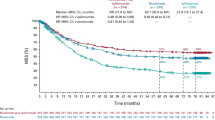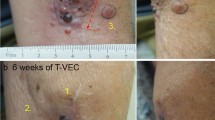Abstract
The possibilities in treating melanoma patients changed dramatically in the last few years. Several new immunotherapies and targeted therapies have demonstrated promising antitumor activity with manageable side effects in patients with advanced melanoma. These include ipilimumab and PD-1(L) antibodies, and the targeted agents vemurafenib (BRAF-inhibitor), dabrafenib (BRAF-inhibitor), and trametinib (MEK-inhibitor). Although early clinical trials have not indicated that any of these offers a “breakthrough” in terms of antitumor activity for all patients, each will likely offer incremental improvements over standard care. Complex immunotherapies with adoptive T-cell transfer after nonmyeloablative lymphodepletion suggest response rates that are extraordinary; however, these results were derived from highly selected patient cohorts in single centers only. In the adjuvant setting interferon-α is still considered standard of care for high-risk melanoma patients. However, improvement rates for overall survival are still low. Therefore, sufficient markers for selection of patients who will profit from interferon-α are urgently needed. Newdrugs such as ipilimumab and BRAF/MEK inhibitors are already in clinical trials in the adjuvant setting, and may probably improve the possibilities to treat patients being at high risk for recurrence in a few years.
Résumé
Les possibilités de traitement des patients atteints de mélanome( s) ont radicalement changé au cours de ces dernières années. Plusieurs nouvelles immunothérapies et thérapies ciblées ont révélé des résultats prometteurs quant à l’activité tumorale avec des effets secondaires gérables sur les patients atteints d’un mélanome avancé. Celles-ci comprennent les anticorps ipilimumab et PD-1(L) ainsi que les agents ciblés suivants: le vemurafenib (inhibiteur de BRAF), le dabrafenib (inhibiteur de BRAF) et le trametinib (inhibiteur de MEK). Bien que de premiers essais cliniques n’aient pas indiqué que l’un de ces éléments constitue une « révolution » en termes d’activité antitumorale pour tous les patients, chacun d’entre eux apportera des améliorations progressives par rapport aux soins standard. Les immunothérapies complexes avec un transfert adoptif de lymphocytes T suite à une lymphodéplétion non myéloablative indiquent des taux de réponse extraordinaires. Cependant, ces résultats sont issus d’une cohorte de patients sélectionnés avec soin dans des centres uniques. Le traitement adjuvant par interféron-α est toujours considéré comme la norme en matière de soins pour les patients atteints d’un mélanome à haut risque. Néanmoins, les taux d’amélioration de la survie globale sont encore bas. Par conséquent, la nécessité d’obtenir des repères suffisants pour la sélection des patients qui bénéficieront de l’interféron-α s’impose de toute urgence. De nouveaux médicaments tels que l’ipilimumab et les inhibiteurs de BRAF/ MEK sont déjà utilisés pour les essais cliniques du traitement adjuvant et pourraient probablement améliorer les possibilités de traitement de patients à haut risque de récidive dans quelques années.
Similar content being viewed by others
References
Atkins MB, Hsu J, Lee S, et al. (2008) Phase III trial comparing concurrent biochemotherapy with cisplatin, vinblastine, dacarbazine, interleukin-2, and interferon alfa-2b with cisplatin, vinblastine, and dacarbazine alone in patients with metastatic malignant melanoma (E3695): a trial coordinated by the Eastern Cooperative Oncology Group. J Clin Oncol 26(35): 5748–5754
Brahmer JR, Tykodi SS, Chow LQ, et al. (2012) Safety and activity of anti-PD-L1 antibody in patients with advanced cancer. N Engl J Med 366(26): 2455–2465
Cameron DA, Cornbleet MC, MacKie RM, et al. (2001) Adjuvant interferon alpha 2b in high risk melanoma: the Scottish study. Br J Cancer 84(9): 1146–1149
Cascinelli N, Belli F, MacKie RM, et al. (2001) Effect of long-term adjuvant therapy with interferon alpha-2a in patients with regional node metastases from cutaneous melanoma: a randomised trial. Lancet 358(9285): 866–869
Chapman PB, Hauschild A, Robert C, et al. (2011) Improved survival with vemurafenib in melanoma with BRAF V600E mutation. N Engl J Med 364(26): 2507–2516
Eggermont AM, Suciu S, MacKie R, et al. (2005) Post-surgery adjuvant therapy with intermediate doses of interferon alfa 2b versus observation in patients with stage IIb/III melanoma (EORTC 18952): randomised controlled trial. Lancet 366(9492): 1189–1196
Eggermont AM, Suciu S, Rutkowski P, et al. (2010) Randomized phase III trial comparing postoperative adjuvant ganglioside GM2-KLH/QS-21 vaccination versus observation in stage II (T3-T4N0M0) melanoma: final results of study EORTC 18961. J Clin Oncol 28(15s): (suppl.) Abstract: 8505
Eggermont AM, Suciu S, Santinami M, et al. (2008) Adjuvant therapy with pegylated interferon alfa-2b versus observation alone in resected stage III melanoma: final results of EORTC 18991, a randomised phase III trial. Lancet 372(9633): 117–126
Eggermont AM, Suciu S, Testori A, et al. (2012) Long-term results of the randomized phase III trial EORTC 18991 of adjuvant therapy with pegylated interferon alfa-2b versus observation in resected stage III melanoma. J Clin Oncol 30(31): 3810–3818
Eigentler TK, Caroli UM, Radny P, Garbe C (2003) Palliative therapy of disseminated malignant melanoma: a systematic review of 41 randomised clinical trials. Lancet Oncol 4(12): 748–759
Erdmann F, Lortet-Tieulent J, Schuz J, et al. (2013) International trends in the incidence of malignant melanoma 1953–2008: are recent generations at higher or lower risk? Int J Cancer 132(2): 385–400
Flaherty KT, Puzanov I, Kim KB, et al. (2010) Inhibition of mutated, activated BRAF in metastatic melanoma. N Engl J Med 363(9): 809–819
Flaherty KT, Robert C, Hersey P, et al. (2012) Improved survival with MEK inhibition in BRAF-mutated melanoma. N Engl J Med 367(2): 107–114
Garbe C, Blum A (2001) Epidemiology of cutaneous melanoma in Germany and worldwide. Skin Pharmacol Appl Skin Physiol 14(5): 280–290
Grob JJ, Dreno B, de la Salmoniere P, et al. (1998) Randomised trial of interferon alpha-2a as adjuvant therapy in resected primary melanoma thicker than 1.5 mm without clinically detectable node metastases. French Cooperative Group on Melanoma. Lancet 351(9120): 1905–1910
Grob JJ, Jouary T, Dreno B, et al. (2013) Adjuvant therapy with pegylated interferon alfa-2b (36 months) versus low-dose interferon alfa-2b (18 months) in melanoma patients without macrometastatic nodes: an open-label, randomised, phase 3 European Association for Dermato-Oncology (EADO) study. Eur J Cancer 49 (1): 166–174
Hancock BW, Wheatley K, Harris S, et al. (2004) Adjuvant interferon in high-risk melanoma: the AIM HIGH Study-United Kingdom Coordinating Committee on Cancer Research randomized study of adjuvant low-dose extended-duration interferon Alfa-2a in high-risk resected malignant melanoma. J Clin Oncol 22(1): 53–61
Hauschild A, Grob JJ, Demidov LV, et al. (2012) Dabrafenib in BRAF-mutated metastatic melanoma: a multicentre, openlabel, phase 3 randomised controlled trial. Lancet 380(9839): 358–365
Hauschild A, Weichenthal M, Rass K, et al. (2009) Prospective randomized multicenter adjuvant dermatologic cooperative oncology group trial of low-dose interferon alfa-2b with or without a modified high-dose interferon alfa-2b induction phase in patients with lymph nodenegative melanoma. J Clin Oncol 27(21): 3496–3502
Hodi FS, O’Day SJ, McDermott DF, et al. (2010) Improved survival with ipilimumab in patients with metastatic melanoma. N Engl J Med 363(8): 711–723
Ives NJ, Stowe RL, Lorigan P, Wheatley K (2007) Chemotherapy compared with biochemotherapy for the treatment of metastatic melanoma: a meta-analysis of 18 trials involving 2,621 patients. J Clin Oncol 25(34): 5426–5434
Kim CJ, Dessureault S, Gabrilovich D, et al. (2002) Immunotherapy for melanoma. Cancer Control 9(1): 22–30
Kirkwood JM, Ibrahim JG, Sondak VK, et al. (2000) High- and low-dose interferon alfa-2b in high-risk melanoma: first analysis of intergroup trial E1690/S9111/ C9190. J Clin Oncol 18(12): 2444–2458
Kirkwood JM, Ibrahim JG, Sosman JA, et al. (2001) High-dose interferon alfa-2b significantly prolongs relapse-free and overall survival compared with the GM2-KLH/QS-21 vaccine in patients with resected stage IIB-III melanoma: results of intergroup trial E1694/S9512/C509801. J Clin Oncol 19(9): 2370–2380
Kirkwood JM, Lee S, Moschos SJ, et al. (2009) Immunogenicity and antitumor effects of vaccination with peptide vaccine+/-granulocyte-monocyte colonystimulating factor and/or IFN-alpha2b in advanced metastatic melanoma: Eastern Cooperative Oncology Group Phase II Trial E1696. Clin Cancer Res 15(4): 1443–1451
Kirkwood JM, Strawderman MH, Ernstoff MS, et al. (1996) Interferon alfa-2b adjuvant therapy of high-risk resected cutaneous melanoma: the Eastern Cooperative Oncology Group Trial EST 1684. J Clin Oncol 14(1): 7–17
Mocellin S, Pasquali S, Rossi CR, Nitti D (2010) Interferon alpha adjuvant therapy in patients with high-risk melanoma: a systematic review and meta-analysis. J Natl Cancer Inst 102(7): 493–501
Morton D, Mozillo N, Thompson J, et al. (2007) An international, randomized, phase III trial of bacillus Calmette-Guerin (BCG) plus allogeneic melanoma vaccine (MCV) or placebo after complete resection of melanoma metastatic to regional or distant sites. J Clin Oncol 25 (18s): (suppl.) Abstract: 8508
Parkinson DR, Abrams JS, Wiernik PH, et al. (1990) Interleukin-2 therapy in patients with metastatic malignant melanoma: a phase II study. J Clin Oncol 8(10): 1650–1656
Pectasides D, Dafni U, Bafaloukos D, et al. (2009) Randomized phase III study of 1 month versus 1 year of adjuvant highdose interferon alfa-2b in patients with resected high-risk melanoma. J Clin Oncol 27(6): 939–944
Pehamberger H, Soyer HP, Steiner A, et al. (1998) Adjuvant interferon alfa-2a treatment in resected primary stage II cutaneous melanoma. Austrian Malignant Melanoma Cooperative Group. J Clin Oncol 16(4): 1425–1429
Robert C, Thomas L, Bondarenko I, et al. (2011) Ipilimumab plus dacarbazine for previously untreated metastatic melanoma. N Engl J Med 364(26): 2517–2526
Rosenberg SA, Yang JC, Sherry RM, et al. (2011) Durable complete responses in heavily pretreated patients with metastatic melanoma using T-cell transfer immunotherapy. Clin Cancer Res 17(13): 4550–4557
Schwartzentruber DJ, Lawson DH, Richards JM, et al. (2011) gp100 peptide vaccine and interleukin-2 in patients with advanced melanoma. N Engl J Med 364 (22): 2119–2127
Sosman JA, Kim KB, Schuchter L, et al. (2012) Survival in BRAF V600-mutant advanced melanoma treated with vemurafenib. N Engl J Med 366(8): 707–714
Topalian SL, Hodi FS, Brahmer JR, et al. (2012) Safety, activity, and immune correlates of anti-PD-1 antibody in cancer. N Engl J Med 366(26): 2443–2454
Zarour HM, Kirkwood JM (2003) Melanoma vaccines: early progress and future promises. Semin Cutan Med Surg 22(1): 68–75
Author information
Authors and Affiliations
Corresponding author
About this article
Cite this article
Eigentler, T.K., Garbe, C. New landscape in the treatment of melanoma: a 2012 update. Oncologie 15, 71–77 (2013). https://doi.org/10.1007/s10269-013-2258-x
Received:
Accepted:
Published:
Issue Date:
DOI: https://doi.org/10.1007/s10269-013-2258-x
Mots clés
- Mélanome
- Traitement adjuvant
- Traitement systémique
- Immunothérapies
- Inhibiteurs de BRAF
- Inhibiteurs de MEK




